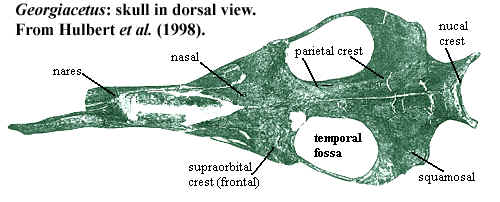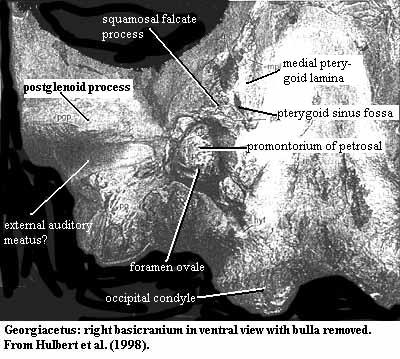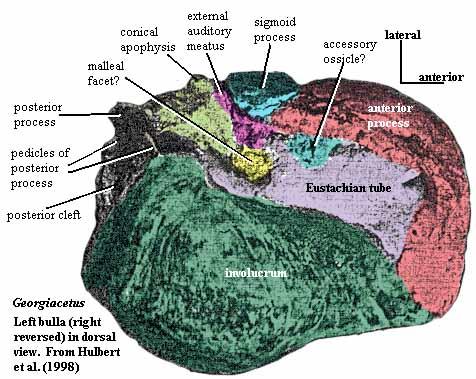
| Palaeos |  |
Cetartiodactyla |
| Vertebrates | Georgiacetus |
| Page Back | Unit Home | Unit Dendrogram | Unit References | Taxon Index | Page Next |
| Unit Back | Vertebrates Home | Vertebrate Dendrograms | Vertebrate References | Glossary | Unit Next |
|
Abbreviated Dendrogram
LAURASIATHERIA |--FERAE `--+--PERISSODACTYLA | CETARTIODACTYLA |--Cetacea | |--Pakicetidae | `--Protocetidae | |--Georgiacetus | `--Basilosauridae | |--Basilosaurus | `--Autoceta `--Artiodactyla |--Suina | |--Hippopotamidae | `--Suoidea `--Selenodontia |--Camelidae `--Ruminantia |--Giraffoidea `--+--Bovoidea `--Cervoidea |
Contents
Overview |
One of the many good things about the description of Georgiacetus cranial anatomy in Hulbert et al. (1998) is that the authors take the time to give us their "best guess" reconstruction of the animal in its Middle Eocene (probably earliest Bartonian) environment. It is always a pleasure to observe a good job of functional reconstruction done from morphology, but it is particularly useful here. Georgiacetus is a rather advanced protocetid which lived just before the advent of the basilosaurids later in the Bartonian (the later Middle Eocene). The basilosaurids arguably represent a departure from the original cetacean body plan, and we would like to know why an anatomical formula which had been successful for 10 or 15 million years suddenly required re-engineering. We will be doing nothing creative here -- simply summarizing Hulbert's discussion as a background to the Basilosauridae.
Georgiacetus had an elongated rostrum -- nothing new here. However, the scarf joints stabilizing the rostral bones on the central skull foreshadow the eventual "telescoping" of the skull elements in autocetes. In modern whales, The rostral bones and/or the occipital bones override the skull table almost completely. Presumably the arrangement was originally advantageous because it strengthened the rostrum for the usual swift lateral head movements used by longirostrine fish eaters to capture prey. The sagittal crest is tall and robust, while the masseteric fossa on the lateral face of the jaw is weak. These features indicate that the primary jaw muscles were the superficial elements of the temporalis. Again, this is consistent with a simple snap-and-gulp style of feeding with little or no chewing. This impression is again confirmed by the simple, conical dentition and vertical wear facets.
Georgiacetus evidently preferred large, active prey. This may be deduced from the reinforcement of the rostral bones, huge temporal fossae (for the jaw muscles), and the presence of a small number of large, relatively blunt teeth showing wear at the tips. The teeth also bear carnassial notches. These suggest that prey animals were often too large to be eaten in a single bite. It was necessary to cut through bone and sever prey into several pieces.
As in all but the earliest whales, the neck vertebrae are short. Georgiacetus had very little neck mobility. Its head was firmly braced on the body, both for strength and to produce a favorable hydrodynamic shape. However, the anterior thoracic vertebrae retain the tall spines of earlier forms, suggesting that the forelimbs still retained an important role in propelling the whale through the water. The lumbar vertebrae are not elongated to the extent seen in basilosaurids, but there is clearly a move in that direction. The pelvis no longer articulates with the spine through a bony connection. However, the femur is relatively large and articulates in a well-formed and clearly functional acetabulum. Hence it probably retained some function in locomotion. Tail elements are unknown, but the hind limbs seem too small to have propelled the animal effectively. Presumably, the tail had a significant role in locomotion, but its precise function is unknown. ATW030201.
 Georgiacetus:
G. vogtlensis Hulbert et
al. 1998.
Georgiacetus:
G. vogtlensis Hulbert et
al. 1998.
Range: middle Eocene (Late Lutetian or Early Bartonian) of Georgia (USA)
Phylogeny: Protocetidae : Basilosauridae + *.
Characters: CEPHALIC premaxillae meet at midline anterior to nares [H+98];
nares located at level of P1 [H+98] [T98]; maxilla forms most of lateral rostrum
[H+98]; maxilla infraorbital foramen anterior to P3 [H+98]; nasopharyngeal duct much taller than wide
[H+98]; nasals long, smoothly widening posteriorly to level of orbits [H+98];
nasals overlapped laterally at scarf joints with premaxilla & maxilla
[H+98]; short process of frontals projects between nasals [H+98]; frontals form
transversely wide, posteriorly thick crest projecting laterally beyond jugals
(!!) [H+98]; sharp horizontal parietal ridge in temporal region [H+98]; sagittal
crest rises smoothly from just posterior to orbits to nuchal crest [H+98]; shallow pterygoid sinus
fossa medial to falciform process of squamosal [H+98]; squamosal with large postglenoid process
bearing most of dentary articulation [H+98]; external auditory meatus behind
postglenoid approaches bulla medially [H+98]; squamosal continues medially to
form dorsal rim of nuchal crest [H+98]; supraoccipital directed almost
vertically above foramen
magnum, bearing pair
of nuchal tubercles [H+98]; nuchal tubercles with deep rugose pit lateral to
each [H+98]; supraoccipital flares posterodorsally above tubercles, forming
concave posterior surface of nuchal crest [H+98]; foramen magnum wide &
flanked by vertical occipital condyles [H+98]; exoccipitals lateral to condyles
strongly joined to squamosal & basioccipital, with prominent paroccipital
process articulating with tympanic bulla [H+98]; promontorium of petrosal
blocky, with flat ventral surface [H+98]; bulla is rectangular with broad
tympanic cavity [H+98]; posterodorsal portion of involucrum
attached to paroccipital process with ligaments [H+98]; vertical cleft of bulla
very deep [H+98]; posterior half of bulla much deeper than anterior portion
[H+98]; premaxilla palatal exposure flat &
without palatine foramen or fissure [H+98]; palatines form flat, triangular
wedge with apex about P4 [H+98]; palatines form base & sides of
nasopharyngeal duct [H+98]; duct continued to choana by alisphenoid &
pterygoid [H+98]; alisphenoid & medial pterygoid laminae continue from
choanae to level of external auditory meatus [H+98] narrow pterygoid sinus fossa
between lamina & falciform process [H+98]; mandibular symphysis not
fused [H+98]; mandibular symphysis extending just mesial to p3 [H+98]; dentary
rami laterally convex, with straight ventral border [H+98]; anterior jaw narrow but tooth rows
abruptly diverge after P2 [H+98]; dentary with 8 mental
foramina [H+98]; moderately tall coronoid process [H+98]; masseteric
fossa small & shallow (in fact, damned near invisible) [H+98];
mandibular foramen & condyle greatly enlarged [H+98]; DENTAL I/i1-P/p1
single-cusped, bluntly conical, with fine ornamentation & thin enamel
[H+98]; incisors & canines single-rooted [H+98]; I2 isolated by small diastemata
mesial &
distal [H+98]; P1-2 and p1-m3 double-rooted [H+98]; P/p2-4 elongate, with thick,
highly ornamented enamel & tall continuous cingula (or cingulids) [H+98]; moderately long diastema after P2
[H+98]; P/p2-4
with highly ornamented enamel [H+98]; P3-M3 triple-rooted (2 buccal & 1
distolingual) [H+98]; small, blunt accessory cusps on some cheek
teeth, notably P3-4 [H+98]; embrasure pits medial to P4-M3 [H+98]; P4-M3 with
large lingual wear facets [H+98]; p4-m3 protoconids separated from metaconids by
carnassial notch [H+98]; protocone reduced [T98]; M/m1-3 secodont, with carnassials
[H+98]; M3 small, without metacone [H+98]; m1-m3 with 2 laterally compressed
cusps [H+98]; m1-m3 with large, tall protoconid separated from cultriform
falciform process of squamosal [H+98]; squamosal with large postglenoid process
bearing most of dentary articulation [H+98]; external auditory meatus behind
postglenoid approaches bulla medially [H+98]; squamosal continues medially to
form dorsal rim of nuchal crest [H+98]; supraoccipital directed almost
vertically above foramen
magnum, bearing pair
of nuchal tubercles [H+98]; nuchal tubercles with deep rugose pit lateral to
each [H+98]; supraoccipital flares posterodorsally above tubercles, forming
concave posterior surface of nuchal crest [H+98]; foramen magnum wide &
flanked by vertical occipital condyles [H+98]; exoccipitals lateral to condyles
strongly joined to squamosal & basioccipital, with prominent paroccipital
process articulating with tympanic bulla [H+98]; promontorium of petrosal
blocky, with flat ventral surface [H+98]; bulla is rectangular with broad
tympanic cavity [H+98]; posterodorsal portion of involucrum
attached to paroccipital process with ligaments [H+98]; vertical cleft of bulla
very deep [H+98]; posterior half of bulla much deeper than anterior portion
[H+98]; premaxilla palatal exposure flat &
without palatine foramen or fissure [H+98]; palatines form flat, triangular
wedge with apex about P4 [H+98]; palatines form base & sides of
nasopharyngeal duct [H+98]; duct continued to choana by alisphenoid &
pterygoid [H+98]; alisphenoid & medial pterygoid laminae continue from
choanae to level of external auditory meatus [H+98] narrow pterygoid sinus fossa
between lamina & falciform process [H+98]; mandibular symphysis not
fused [H+98]; mandibular symphysis extending just mesial to p3 [H+98]; dentary
rami laterally convex, with straight ventral border [H+98]; anterior jaw narrow but tooth rows
abruptly diverge after P2 [H+98]; dentary with 8 mental
foramina [H+98]; moderately tall coronoid process [H+98]; masseteric
fossa small & shallow (in fact, damned near invisible) [H+98];
mandibular foramen & condyle greatly enlarged [H+98]; DENTAL I/i1-P/p1
single-cusped, bluntly conical, with fine ornamentation & thin enamel
[H+98]; incisors & canines single-rooted [H+98]; I2 isolated by small diastemata
mesial &
distal [H+98]; P1-2 and p1-m3 double-rooted [H+98]; P/p2-4 elongate, with thick,
highly ornamented enamel & tall continuous cingula (or cingulids) [H+98]; moderately long diastema after P2
[H+98]; P/p2-4
with highly ornamented enamel [H+98]; P3-M3 triple-rooted (2 buccal & 1
distolingual) [H+98]; small, blunt accessory cusps on some cheek
teeth, notably P3-4 [H+98]; embrasure pits medial to P4-M3 [H+98]; P4-M3 with
large lingual wear facets [H+98]; p4-m3 protoconids separated from metaconids by
carnassial notch [H+98]; protocone reduced [T98]; M/m1-3 secodont, with carnassials
[H+98]; M3 small, without metacone [H+98]; m1-m3 with 2 laterally compressed
cusps [H+98]; m1-m3 with large, tall protoconid separated from cultriform
 hypoconulid by vertical carnassial notch [H+98]; m1-m3 with continuous cingulum
[H+98]; m1-m3 with carinae bearing accessory cusps running from protoconid to
mesiolingual & mesiobuccal corners [H+98]; smooth
cristid obliqua [H+98]; m1-m3 with large buccal wear facets [H+98]; AXIAL
longer body than more basal protocetids [B98]; vertebral
formula C7T13L8S4 [H+98]; all vertebrae with large, flat zygapophyses [H+98];
cervicals moderately shortened [B98]; all postcervical vertebrae with elongated centra [H+98]; ribs long, slender, slightly expanded distally &
pachyostotic except at ends [H+98];
T1-10 with tall, posterodorsal spines [H+98]; T12-13 are functional lumbars
[B98]; anterior thoracics with width somewhat larger than height [B98];
posterior thoracics & anterior lumbars with width much greater than height
[B98]; lumbar vertebrae with tall spines flat transverse processes projecting
anterolaterally [H+98]; width/height ratio minimum just anterior to sacrals
[B98]; sacral vertebrae with large, dorsolaterally-projecting metapophyses and long,
distally thickened transverse processes [H+98]; sacrals lumbarized [B98]; peak
of centrum length in caudals (suggesting probable peduncle & fluke?) [B98]; APPENDICULAR
no fusion between sacrals or
between ilium and
sacrals [H+98]; innominate elongate, with reduced ischium & widened pubis [H+98];
pelvis probably attached to vertebrae via soft tissue only [B98]; large acetabulum with well-formed articular surface [H+98]; large, oval obturator
foramen [H+98]; pubic symphysis present, but relatively short [H+98].
hypoconulid by vertical carnassial notch [H+98]; m1-m3 with continuous cingulum
[H+98]; m1-m3 with carinae bearing accessory cusps running from protoconid to
mesiolingual & mesiobuccal corners [H+98]; smooth
cristid obliqua [H+98]; m1-m3 with large buccal wear facets [H+98]; AXIAL
longer body than more basal protocetids [B98]; vertebral
formula C7T13L8S4 [H+98]; all vertebrae with large, flat zygapophyses [H+98];
cervicals moderately shortened [B98]; all postcervical vertebrae with elongated centra [H+98]; ribs long, slender, slightly expanded distally &
pachyostotic except at ends [H+98];
T1-10 with tall, posterodorsal spines [H+98]; T12-13 are functional lumbars
[B98]; anterior thoracics with width somewhat larger than height [B98];
posterior thoracics & anterior lumbars with width much greater than height
[B98]; lumbar vertebrae with tall spines flat transverse processes projecting
anterolaterally [H+98]; width/height ratio minimum just anterior to sacrals
[B98]; sacral vertebrae with large, dorsolaterally-projecting metapophyses and long,
distally thickened transverse processes [H+98]; sacrals lumbarized [B98]; peak
of centrum length in caudals (suggesting probable peduncle & fluke?) [B98]; APPENDICULAR
no fusion between sacrals or
between ilium and
sacrals [H+98]; innominate elongate, with reduced ischium & widened pubis [H+98];
pelvis probably attached to vertebrae via soft tissue only [B98]; large acetabulum with well-formed articular surface [H+98]; large, oval obturator
foramen [H+98]; pubic symphysis present, but relatively short [H+98].
Links: SavannahNOW - Savannah Morning News - Local News - Introducing ...; 40-Million-Year-Old Whale Gets Name; The Emergence of Whales, Chp. 8 (and succeeding pages); CNN - Public gets first view of 40 million-year-old whale fossil ... ; CFZ Newsfile- Palaeontology; North America's oldest whale fossil to be displayed.
References: Buchholtz (1998) [B98]; Hulbert et al. (1998) [H+98] Thewissen (1998) [T98]. ATW030327.
| Page Back | Unit Home | Page Top | Page Next |
checked ATW051030